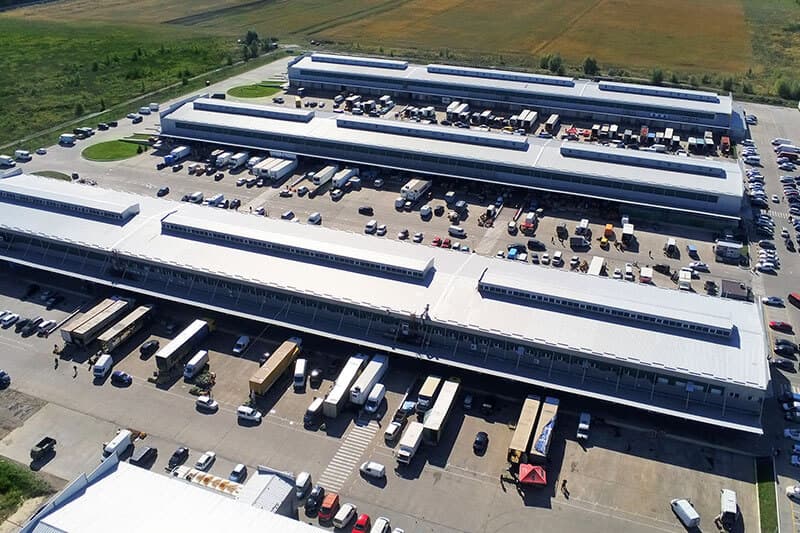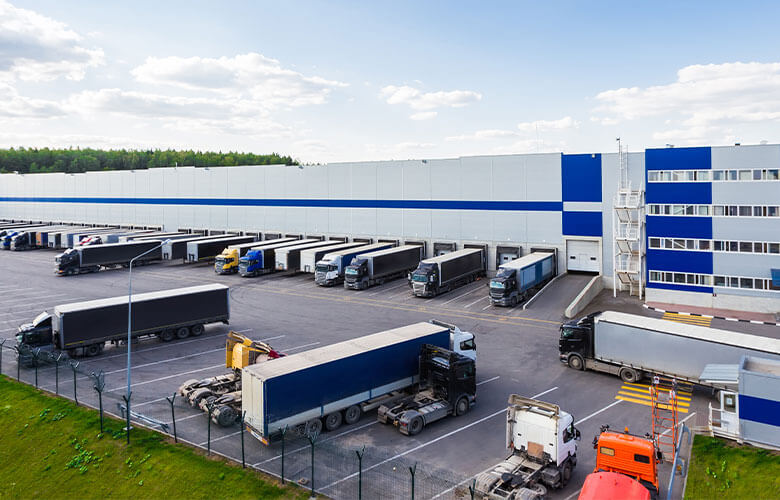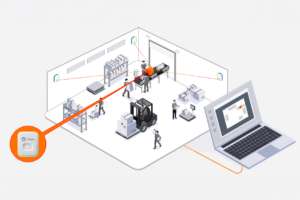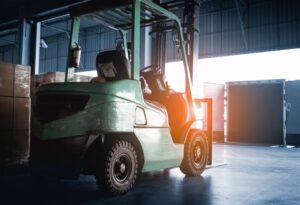Contents
What is A Yard Management System?
A yard management system, or YMS, is an integral part of modern logistics and is the backbone of the global supply chain. Well-functioning yard management services can keep your manufacturing facility running smoothly and ensure that your goods are delivered on time. This blog post will explain what a yard management system RTLS powered by RFID is. We’ll also discuss the benefits of using a YMS in your factory and how to pick one!
Yard Management Definition
A yard management system (YMS) with Real-Time Location Systems (RTLS) is characterized as an application that enhances the efficiency of coordinating activities within an industrial or freight-handling yard. These activities encompass the receipt, storage, and dispatch of materials.
In the supply chain industry, the integration of yard management systems and supply chain visibility stands as two pivotal concepts. RTLS yard management systems, particularly those incorporating RTLS, empower organizations to efficiently oversee their inventory and shipment processes. Concurrently, supply chain visibility enables the monitoring and effective management of the entire goods flow across the supply chain.
The definition of yard management has evolved alongside technological advancements, transitioning from traditional methods like walkie-talkies and paperwork to more sophisticated solutions incorporating RFIDs and cloud-based systems.
Evolution of Yard Management Systems
The first generation of yard management systems (YMS) was introduced in the early 1990s and was based on host-based yard management software that provided gate, trailer, and chassis tracking. These systems were designed to track the location of assets within a yard and improve the efficiency of operations by reducing search time for empty trailers and available chassis. The second generation of YMS, which emerged in the late 1990s, added support for yard trucks and provided real-time visibility of assets and their status within the yard. In addition, these systems began to offer integration with transportation management systems (TMS) to provide end-to-end visibility of shipments.
The third generation of YMS, which is currently the most advanced, offers several new features and capabilities. These systems are web-based and provide real-time tracking of all assets in the yard and integration with various enterprise systems. In addition, they offer built-in optimization algorithms that help to improve the efficiency of yard operations. The fourth generation of YMS, which is currently in development, promises to alter the yard management definition with even more advanced features such as predictive analytics and machine learning that can further improve the efficiency of yard operations.
What industries need a yard management system RTLS?
One of the main benefits of a yard management system is that it can help improve organization and efficiency in many industries. Many different industries can benefit from using a yard management system, including:
- Manufacturing
- Shipping and Receiving
- Warehousing
Each of these industries has its own unique set of needs, but a yard management system can help improve organization and efficiency.
A shipping and receiving company can use a yard management system to keep track of incoming and outgoing shipments. This can help expedite transportation operations and that there are no delays due to misplaced or lost loads.
By using a yard management system RTLS, organizations can improve their supply chain visibility and ensure that goods flow smoothly throughout their supply chains.
How Does a Yard Management System RTLS Work?
A Yard Management System RTLS typically consists of three main components:
- A tracking system that uses UWB-based active RFID (RTLS) tags or GPS devices to track vehicles and assets in the yard
- An automated gate system that uses RTLS tags to track vehicles as they enter and exit the yard
- A software application that provides a user interface for managing yard operations
The tracking system keeps track of vehicles and assets in the yard. The tracking system is interfaced with the software application, which provides a user interface for managing yard operations. The gate system controls traffic flow in and out of the yard.

What processes are in a yard management system?
A yard management system typically consists of four main components:
- Check-in/Check-out: This component tracks when vehicles arrive and depart from the yard.
- Traffic Control: This component manages traffic flow in the yard and ensures that vehicles are adequately spaced out to avoid accidents.
- Yard Shifting and Departure Control: A well-designed yard management system rtls can have a profound impact on loading times. By optimizing the flow of traffic and maximizing the use of available space, a yard management system can ensure that trucks are loaded quickly and efficiently.
Typical yard management processes will also include several other features, such as gate control, vehicle tracking, and reporting. However, the four components listed above are the core components of a yard management system.
Check-in/Check-out
A yard management system’s check-in/check-out component tracks when vehicles arrive and depart from the yard. This information is used to track the status of cars in the yard and ensure that all vehicles are accounted for.
The check-in/check-out component typically includes scanning the barcodes of arriving and departing vehicles. This information is then stored in a database, which can be accessed by the other parts of the yard management system.
Traffic Control
The traffic control component of a yard management system rtls manages the flow of traffic in the yard and ensures that vehicles are adequately spaced out to avoid accidents. This component typically includes several sensors used to detect the location of cars in the yard.
These sensors are then used to generate a real-time map of the yard, which the traffic control system operates to direct the flow of traffic. The traffic control system also includes several rules to ensure that vehicles are adequately spaced out and that accidents are avoided.
Yard Shifting
The yard shifting component of a yard management system moves vehicles around the yard to make room for new arrivals and ensure that all vehicles are correctly parked. This component typically includes several sensors used to detect the location of vehicles in the yard.
Departure Control
The departure control component of a yard management system manages the departure of vehicles from the yard and ensures that all vehicles are accounted for. This component typically includes a scanner used to scan the barcodes of departing vehicles. This information is then stored in a database, which can be accessed by the other components of the yard management system.
The departure control component also typically includes several rules to ensure that all vehicles are accounted for before leaving the yard.The fundamental core of this system is the ability to acquire data over a wireless network like through RFID.
Yard Management System RTLS
RTLS is a newer technology becoming more popular in yard management systems. This type of RFID uses battery-powered tags that periodically broadcast their ID and other information. The reader picks up this signal and can then provide real-time location tracking for the tag.
One of the main advantages of using RTLS tags in a yard management system is the real-time tracking they can provide. With passive RFID, the tag is only read when it comes into proximity with the reader. This means that there can be a significant delay in getting information about the asset’s location. With RTLS, the tag is constantly broadcasting its location, so the reader can provide up-to-the-minute information about where an asset is located. This is especially important in a yard management system where it is crucial to know the exact location of assets.
Another advantage of using active RFID tags is the more extended read range. With passive RFID, the tag is only readable when within a few feet of the reader. It can be challenging to track assets spread out over a large area. Active RFID tags, on the other hand, can often be read from hundreds of feet away. This means that you can track assets more accurately and over a larger area.
RTLS tags also typically have more memory than passive RFID tags. This means that they can store more information about the asset they are attached to. This can be important in a yard management system where you need to track data about each asset. Tags offer many advantages over passive RFID tags in a yard management system. They provide real-time tracking, longer read ranges, and more memory. This makes them the ideal choice for many applications.
Benefits of a Yard Management System RTLS
It can provide several advantages for factories and warehouses, including:
- Improved efficiency – A YMS can help optimize traffic flow in and out of the yard, reducing wait times and improving efficiencies.
- Better decision making – A YMS can provide real-time visibility into the yard, helping managers make better decisions about running their operations.
- Reduced costs – A YMS can help reduce the cost of operating a factory or warehouse by reducing the need for manual labor from yard employees.
What should you look for in a Yard Management System?
There are many factors to consider when choosing yard management solutions. The first and most important factor is what the system can do for your specific business. It would help if you ensured that the system could accommodate all of your needs.
Some other factors you will want to consider include:
- Ease of use
- The ability to customize the system to your specific needs
- Integration with other systems
- The cost of the system
Make sure to ask the vendor many questions before you make your decision. Get as much information as you can to make an informed choice. Choosing the best yard management software is essential for the success of your business.
Litum Yard Management RTLS
A yard management system is a critical piece of equipment for any industry that relies on the movement and storage of goods. By understanding the yard management definition, how it works, and the benefits it can provide, you can decide whether or not this type of system is right for your business.
If you’re looking for a yard management system that can improve your material handling processes, turnaround times, and overall efficiency, Litum Real-Time Location Systems is the answer. Our systems are designed to create a digital twin of your yard and help you identify bottlenecks so you can fix them. We also integrate forklift tracking and employee tracking to improve loading and unloading times further.




